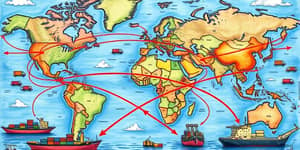
The world stands at a crossroads where economic growth must align with planetary health. As climate risks escalate and finite resources dwindle, the green economy emerges not only as an environmental necessity, but as a powerful driver of long-term prosperity.
Investors, policymakers, and businesses are now placing sustainability at the heart of strategy, seeking opportunities that deliver both strong returns and ecological benefits.
The green economy is low carbon, resource efficient and socially inclusive, aiming to boost employment and income growth through targeted investments. It encompasses companies providing products and services with environmental benefits—ranging from renewable energy and clean water solutions to energy-efficient buildings and recycling services.
By reducing emissions, pollution, and resource use while enhancing biodiversity and ecosystem services, the green economy redefines value creation and risk management for the 21st century.
As of Q1 2025, the global green economy is valued at $7.9 trillion, with revenues from green products and services surpassing $5 trillion for the first time in 2025. Since 2008, green sectors have outperformed the benchmark market by 59%, demonstrating robust resilience even amid volatility.
Emerging green opportunities—spanning critical minerals, green tech, eco-materials, and green services—currently total $2 trillion and could swell to $11 trillion by 2040 under aggressive net-zero trajectories.
Major sectors driving green growth present compelling entry points for investors willing to back transformative innovation:
Analysts estimate annual investments of $1.05 to $2.59 trillion—approximately 2% of global GDP—to decarbonize central economic sectors. Far from a burden, these allocations can stimulate growth, enhance productivity, and unlock new revenue streams.
Early movers benefit from policy incentives, first-mover advantages, and the chance to shape emerging supply chains, establishing durable competitive moats.
Major elections in over 60 countries during 2024 and 2025 have shifted climate agendas, prompting regulatory realignments. In the United States, anticipated deregulatory moves at the federal level may be offset by state and industry-led sustainability initiatives.
Energy security concerns and economic pressures have at times encouraged fossil fuel reliance, particularly as data center power demands surge. However, the European Union and China continue aggressive policy implementation: China installed over 200 GW of new solar capacity in 2023 and expects electric vehicles to represent 30% of domestic auto sales by 2025.
Countries that champion green industries today can diversify risk profiles and future-proof their economic structures against shifting global norms.
The transition toward a circular economy prioritizes resource efficiency across production, consumption, recycling, and waste reduction. Governments are crafting regulations to incentivize closed-loop manufacturing and product stewardship.
Artificial Intelligence is rapidly becoming integral to the green revolution: from forecasting extreme weather events to optimizing grid operations, managing water networks, and tracing waste streams via blockchain technology.
Solar power adoption, electric vehicle penetration, and smart grid deployments are altering energy mixes and industrial strategies across major economies.
Today’s consumers exert unprecedented influence over corporate practices. Surveys reveal that 72% of global consumers are willing to pay a premium for sustainable products, a trend especially pronounced among Gen Z and Millennials.
Businesses that embed environmental, social, and governance criteria into core strategy can mitigate liabilities, attract talent, and foster long-term shareholder value.
The International Monetary Fund forecasts global growth of 2.9% in 2025, down from 3.3% in 2024, as structural shocks—tariffs, shifting supply chains, and policy uncertainty—apply downward pressure.
Inflation is expected to slow to 2.1% in 2025 and 2.0% in 2026, likely leading to interest rate cuts. Lower financing costs enhance the appeal of long-duration green projects such as infrastructure upgrades and renewable energy builds.
Europe and China are ramping up infrastructural spending to support green transitions, ensuring economic resilience while meeting climate commitments.
Short-term volatility remains a hallmark of green markets. Rapid technological evolution in the automotive and critical minerals sectors, coupled with policy oscillation, can introduce sharp price swings and supply disruptions.
Slowing economies, geopolitical tensions, and commodity price fluctuations add layers of uncertainty. In some regions, coal and other fossil fuels continue to represent over 60% of power generation, complicating decarbonization pathways.
Mitigating these risks requires agile risk management, diversified portfolios, and close alignment with evolving regulatory frameworks.
The green economy wave is more than a passing trend—it is an essential evolution of global markets toward sustainability and resilience. Investors, corporations, and governments must collaborate to scale solutions, de-risk transitions, and unlock mutual benefits.
By embracing these principles, stakeholders can seize the potential of a green economy valued in the trillions, delivering not just financial returns, but healthier ecosystems and more inclusive prosperity for future generations.
References













